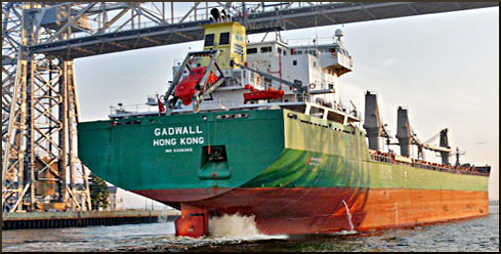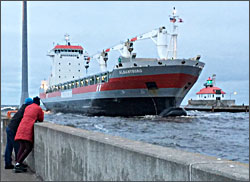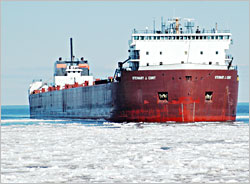The season's first ships
When the Great Lakes shipping season starts, boat nerds watch for salties.

© Beth Gauper
Like robins and maple sap, Lake Superior ore boats aren't much affected by the never-ending winter that humans find so annoying.
Toward the end of March, ice-breakers arrive to clear the shipping lanes, allowing the first boats to leave winter layup, kicking off the spring shipping season.
Then traffic starts to move within Lake Superior. Normally, boats arriving from other lakes can go through the Soo Locks in Sault Ste. Marie after they open on March 25. But in 2024, after a virtually ice-free winter, the locks will open on March 22.
Ah, but when will the first oceangoing boat arrive in Duluth? Whoever guesses that wins the annual First Ship Contest sponsored by the city and the Duluth Seaway Port Authority, and the grand prize of an all-expenses-paid trip to the port town. Entries must be received by March 20.
It's not easy to guess that first arrival date. Here's what happened in past years — good luck!
The winter of 2023 seemed interminable, with near-record amounts of snow . . . and yet the arrival of the Federal Dart from Turkey on March 28 was the earliest arrival on record.
After the colder than average winter of 2022, the Resko arrived on April 13 to pick up wheat for Italy.
In 2021, there was very little ice on Lake Superior and the Soo Locks opened a day early, but the first saltie, the Marshall Islands-flagged Federal Biscay, didn't arrive until April 18, carrying a cargo of cement.
In the relatively mild winter of 2020, the Marshall Islands-flagged Federal Churchill arrived in the evening of April 8 to load wheat bound for Italy.
The winter of 2019 seemed interminable, but the Malta-flagged Maria G arrived only a little on the late side, anchoring April 13 and heading into the harbor April 15 to load wheat bound for Italy. As the Gadwall, it also was first in 2008.
After the similarly long winter of 2018, the Marshall Islands-flagged Federal Weser arrived April 12 to load wheat bound for Algeria.
In 2017, the first saltie was the Antigua-flagged Lake Ontario, which arrived April 2. In 2016, the first saltie was the Dutch-flagged Albanyborg, arriving on April 3. It dropped off a load of German wind-turbine parts in Port Colborne, Ont., and continued to Duluth for a load of wheat bound for Italy.
In 2015, the first saltie was the Malta-flagged Kom, which arrived April 13.
You may think that the colder and longer the winter, the later the arrival — and that was true in 2014, the year of the polar vortex.
That year, ice on the Great Lakes was so heavy that navigation on the Montreal/Lake Ontario section of the St. Lawrence Seaway was delayed until March 31.

© Beth Gauper
On Lake Superior, Coast Guard ice cutters had to escort lakers in convoys from the Soo Locks.
The first saltie didn't arrive until May 7, and even then, the 435-foot Antigua-flagged Diana needed help from two ice-breaking tugs and a 1,000-foot laker, whose bulk helped cleared the way for the little Diana.
The ship had traveled from Brazil; it loaded wheat in Duluth and headed for Algeria.
That was the latest first arrival since May 3 in 1959, the year the St. Lawrence Seaway opened.
However, the winter of 2013 also seemed to drag on. And yet, the Hong Kong-flagged Federal Hunter broke a record set in 1995 when it arrived in the early hours of March 30.
Another saltie, its Cyprus-flagged sister ship, the Federal Elbe, arrived later the same day but had to wait at anchor for its turn at the grain terminals.
In 2012, March was shockingly warm, but the Dutch-flagged Arubaborg arrived April 10, just two days shy of the then-record for late arrival.
What you need to know
The Welland Canal, which allows ships to bypass Niagara Falls, usually opens March 28, but not always. In 2019, it opened March 22.
The 26-mile canal connects lakes Ontario and Erie and allows boats to get around Niagara Falls.
Lakers can move around each Great Lake as soon as ice is out; on Lake Superior, they shuttle between Thunder Bay, Silver Bay, Two Harbors and Duluth-Superior.
After the Soo Locks in Sault Ste. Marie open on March 25, they can take their loads to the steel plants on lakes Michigan and Erie.

© Torsten Muller
But salties, most of which are coming for loads of grain, tend to take their time. Their schedules, like those of the lakers, are dictated not only by weather but also by the economy and demand for the goods they carry.
A tip
Arrival times also can be influenced by harbor fees, which kick in once a boat goes under the Aerial Lift Bridge. Often, boats have to wait their turns to load, so they anchor outside the harbor, where the parking is free.
And sometimes, they wait to avoid paying weekend fees to tugboat pilots and dock handlers. That's what happened in 2019, when the Maria G arrived on a Saturday and waited until 6:48 a.m. Monday to enter the harbor. The winning First Ships guess was 6:30 a.m. Monday.
Check Marine Traffic for ship locations and Duluth Boat Forecast for estimated arrival and departure times. A live webcam records canal traffic.
For more shipping tips, check Boat Nerd, which displays a map of real-time vessel locations on the Seaway.
Cruise raffles
The Lake Superior Marine Museum Association in Duluth holds an annual raffle for a 5½-day cruise on the 1,000-foot freighter Edwin H. Gott, and members get a free entry. Membership is $45 and includes many other benefits and discounts.
For more, see Boat watching in Duluth.